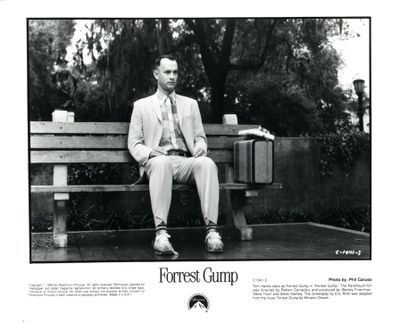‘Forrest Gump’ to be preserved
Film makes Library of Congress’ selections for national registry

WASHINGTON – Bambi, Forrest Gump and Hannibal Lecter have at least one thing in common: Their cinematic adventures were chosen by the Library of Congress to be preserved in the world’s largest archive of film, TV and sound recordings.
“The Silence of the Lambs” (1991), a disturbing psychological thriller about the cannibalistic serial killer Lecter, and “Forrest Gump” (1994), starring Tom Hanks as the simple-minded hero who thinks “life is like a box of chocolates,” were critical and commercial successes that won the Academy Award for Best Picture. The animated Disney classic “Bambi” is among the most beloved movies ever made.
A majority of the titles chosen this year for inclusion in the National Film Registry are lesser-known – including silent films, documentaries, avant-garde cinema and even home movies. The Library of Congress announced the selections Tuesday.
The registry began in 1989 under the terms of the National Film Preservation Act and includes 575 films. Its aim is not to identify the best movies ever made but to preserve films with artistic, cultural or historical significance.
“Forrest Gump” has its critical detractors but was praised for its technical achievements, including the seamless incorporation of the title character into historical footage.
More than 2,200 films were nominated for the registry this year. The National Film Preservation Board pares them down before Librarian of Congress James H. Billington makes the final selections.
“Each year, we do try to pick one of the titles that the public nominated the most, and ‘Forrest Gump’ was way up there on that list,” said Stephen Leggett, program coordinator for the National Film Preservation Board. “Everything on the list is subject to dissenting opinion.”
For each title, the Library of Congress Packard Campus for Audio Visual Conservation works to ensure that the film is preserved for future generations. That comes either by the Library’s massive motion-picture preservation program or through collaborating with other archives, motion-picture studios and independent filmmakers.
“These films are selected because of their enduring significance to American culture,” Billington said in a statement. “Our film heritage must be protected because these cinematic treasures document our history and culture and reflect our hopes and dreams.”
Films must be at least 10 years old to be considered.
The oldest movies selected are both from 1912. “The Cry of the Children” is about the pre-World War I child labor reform movement, and “A Cure for Pokeritis” featuring John Bunny, is regarded as the American film industry’s earliest comic superstar.
“A lot of people would argue that the humor is kind of dated,” Leggett said of Bunny’s films – mostly domestic comedies in which he played a henpecked husband. “He really was a major figure at the time. It doesn’t help your reputation when people like Charlie Chaplin and Buster Keaton come after you.”
Chaplin’s first feature, “The Kid” (1921), was also chosen for the registry.
It was a big year for actress Sally Field, who co-starred in “Forrest Gump.” “Norma Rae” (1979), featuring her Oscar-winning performance as a single mother who fought to unionize a Southern textile mill, also made this year’s list.
Among the other titles chosen: “The Big Heat,” a 1953 film noir starring Glenn Ford; “The Lost Weekend,” Billy Wilder’s Oscar-winning alcoholism drama; “Porgy and Bess,” starring Sidney Poitier and Dorothy Dandridge; and John Ford’s epic 1924 Western “The Iron Horse.”
Lesser-known films were chosen for their significance to the art.
“A Computer Animated Hand” from 1972 is by Pixar Animation Studios co-founder Ed Catmull. The one-minute film that is one of the earliest examples of 3-D computer animation displays the hand turning, opening and closing, pointing at the viewer and flexing its fingers.
Making the list were notable documentaries as well.
“Crisis: Behind a Presidential Commitment,” focuses on Gov. George Wallace’s attempt to prevent two African-American students from enrolling in the University of Alabama and the response of President John F. Kennedy. “Growing Up Female” from 1971 was one of the first films to come from the women’s liberation movement.
Also included was “The Negro Soldier,” produced by Frank Capra. It showed the heroism of blacks in the nation’s wars and became mandatory viewing for all soldiers from spring 1944 until World War II’s end.